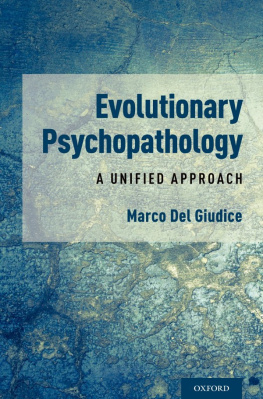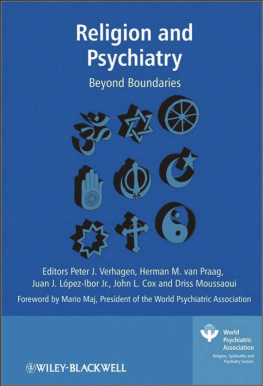Classifying Psychopathology
Mental Kinds and Natural Kinds
edited by Harold Kincaid and Jacqueline Sullivan
The MIT Press
Cambridge, Massachusetts
London, England
2014 Massachusetts Institute of Technology
All rights reserved. No part of this book may be reproduced in any form by any electronic or mechanical means (including photocopying, recording, or information storage and retrieval) without permission in writing from the publisher.
Library of Congress Cataloging-in-Publication Data
Classifying psychopathology : mental kinds and natural kinds / edited by Harold Kincaid and Jacqueline A. Sullivan.
p. cm. (Philosophical psychopathology)
Includes bibliographical references and index.
ISBN 978-0-262-02705-2 (hardcover : alk. paper)
ISBN 978-0-262-32244-7 (retail e-book)
1. Mental illnessClassification. 2. Psychology, Pathological.I. Kincaid, Harold, 1952editor of compilation. II. Sullivan, Jacqueline A., editor of compilation.
RC455.2.C4C582014
616.89dc23
2013031918
Preface
This volume brings together a number of perspectives on the issue of whether mental disorders are natural kinds. Some of the contributors presented papers at a workshop on Natural Kinds and Classification in Psychopathology held at the University of Alabama at Birmingham in April of 2009. The workshop generated enough interest that some of the participants enthusiastically agreed to contribute to a volume. Philosophers who had been active participants in debates about natural kinds in philosophy of psychiatry were also invited to contribute.
1 Classifying Psychopathology: Mental Kinds and Natural Kinds
Harold Kincaid and Jacqueline Sullivan
According to the Mental Health Atlas (World Health Organization 2011, p. 13), neuropsychiatric disorders are estimated to contribute to 13% of the global burden of diseasethat is, more than 450 million people suffer from neuropsychiatric disorders. They are leading causes of disability-adjusted life years, accounting for 37 percent of the healthy years lost from all non-communicable diseases. Depression alone accounts for one-third of this (Insel 2011).
The global cost of mental illness is estimated at 2.5 trillion US dollars and is expected to increase to more than 6 trillion dollars by 2030 (World Health Organization 2011). In the United States alone, estimates indicate that mental-health disorders account for 59 percent of the economic costs that stem from injury or illness-related loss of productivity (ibid.). Perhaps surprisingly, the economic burden of mental-health disorders stems less from the cost of care than from loss of income due to unemployment, expenses for social supports, and a range of indirect costs due to chronic disability that begins early in life (Insel 2011). According to the director of the National Institutes for Mental Health, considering that those with mental illness are at high risk for developing cardiovascular disease, respiratory disease, and diabetes, the true costs of mental illness must be even higher (ibid.).
While awareness of the cost of mental disorders is increasing, doubts about overmedicalizationabout treating what really are problems in living as if they were medical diseases calling for pharmacological treatmentare also increasing. For example, there is evidence that certain sociological and economic pressures on the development of manuals such as the Diagnostic and Statistical Manual of Mental Disorders have eroded historically preserved distinctions between categories differentiating normal types of human suffering from mental disorder and dysfunction. A classic case in point, analyzed by Allan Horwitz and Jerome Wakefield in their 2007 book The Loss of Sadness, is the late-twentieth-century erosion of the boundaries between sadness and depression. (See chapter 11 below.) At one time, the two categories were kept distinct. However, the operationalization of depressive disorder put forward in the fourth edition of Diagnostic and Statistical Manual of Mental Disorders (referred to as DSM-IV) included conditions that served to broaden the kinds of phenomena picked out by the concept to the extent that what was previously considered sadness came to be lumped together with what was previously considered major depression. As the class of persons picked out by the category became more heterogeneous, the number of persons diagnosed as depressed increased, as did the number of prescriptions for anti-depressants. The removal of the grief and bereavement clause from the fifth edition of the DSM (2013) further broadens the category of major depression by allowing doctors to diagnose individuals suffering from sustained grief due to loss of a loved one as having major depression. This move is likely to impede the search for the causes of depression further and to result in an increase in the overuse of psychotropic drugs.
This volume asks whether psychiatry as a science may better position itself to cure mental-health disorders by considering whether improvements to the current criteria for classifying mental disorders are warranted or whether the classification schemes are fine as they stand. Either directly or indirectly, the authors take up the question of whether mental disorders are natural kinds. The basic idea behind the concept of natural kinds is that science identifies the most fundamental entities of nature and shows how they are interrelated. In the case of mental disorders, psychiatric categories ought to group together phenomena in such a way that those phenomena are subject to the same type of causal explanation (see, e.g., Craver 2009) and respond similarly to the same kinds of causal interventions (see, e.g., Woodward 2003). If psychiatric categories do not find such groupings, then there is reason to revise and/or eliminate existing classifications.
This volume is thus organized around the scientific ideal of natural kinds and the extent to which psychiatry can and currently does identify them. The notion of natural kinds can be read in multiple ways. It will be useful to set out some of the main variants of the concept of natural kind here.
All senses of natural kinds assume that there is something out there in the world that grounds classifications. The open questions are What is that something like? and What kinds of classifications can it ground? The strongest sense of natural kinds, often called essentialism, thinks that there are sets of individually necessary and jointly sufficient properties for a given kind that entail a strict in or out classification of all individuals. The weakest sense asserts only that some properties are statistically associated; it allows for no sharp, non-arbitrary categorizing of individuals who lie on a continuum. Various other notions fall between these two poles. Pragmatic approaches might agree with the weak continuum picture but think that practical reasons such as cost effectiveness might allow for drawing motivated boundaries. The view adopted most often in this volume allows for natural kinds without a single set of necessary and sufficient conditions but instead with multiple different property combinations with family resemblance similarity relations.
These are some main contours of different views of natural kinds. There are further sophistications possible beyond these basic views, and some of them are explored in this volume. The chapters are generally united, however, in the belief that it is important for practice and scientific inquiry to get clear about what sense of natural kinds is at work in any particular classification of psychopathology.
Many of those who have participated in the natural-kinds debate about psychiatry are realists about mental disorders and would like it to be the case that psychiatric classification systems such as that of the










